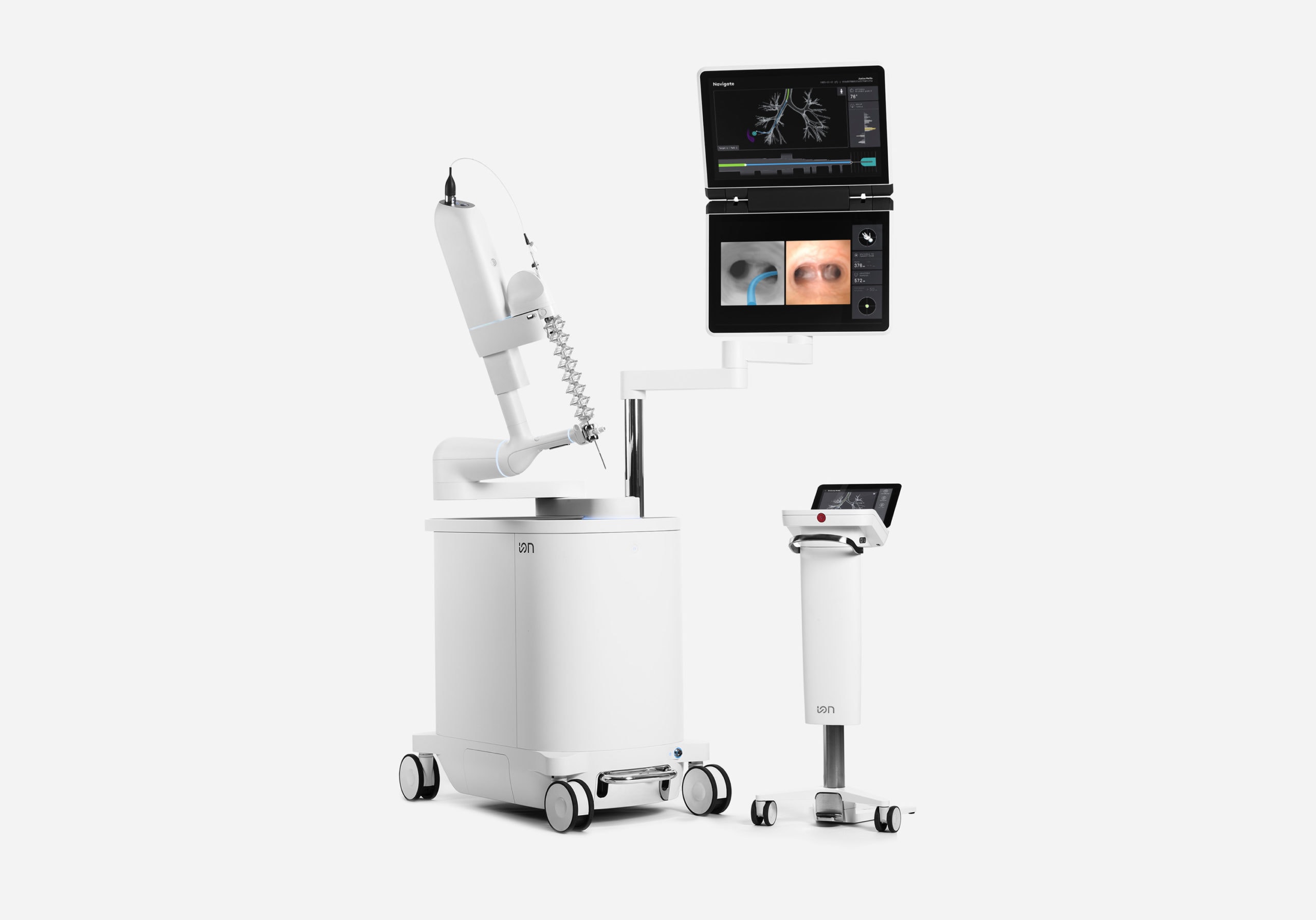View Larger Image

The Ion Endoluminal Robotic Bronchoscopy System made by Intuitive
Image by Intuitive
New Lung Biopsy Robot at UAMS Detects Early-Stage Cancer in Far Reaches of Lung
| Doctors at the University of Arkansas for Medical Sciences (UAMS) recently activated the first lung biopsy robot in Arkansas. The robot allows doctors to discover and biopsy previously undetectable cancerous nodules in the far reaches of the lungs.
“This enables us to visualize and precisely biopsy lung nodules so we can catch lung cancer in its early stages and increase survival rates,” said Nikhil Meena, M.D., an interventional pulmonologist and associate professor in the UAMS College of Medicine Department of Internal Medicine.
The Ion Endoluminal Robotic Bronchoscopy System, made by Intuitive, was used at UAMS for the first time on Sept. 14, enabling Meena to find early cancerous nodules in the lungs of two patients.
Meena said the first patient had a nodule that earlier technology didn’t allow to be biopsied adequately. The second patient had multiple small nodules, two of which were found to be cancerous.
The robotic system employs groundbreaking technology allowing physicians to perform minimally invasive peripheral lung biopsies. The technology includes an ultra-thin, easily maneuverable catheter that enters the body through a natural opening, like the mouth, and can move 180 degrees in all directions. With this system, doctors can navigate through very small airways to reach any airway segment within the lung, while patients are under general anesthesia. The flexible biopsy needle can also pass through very tight bends via the catheter to collect tissue in all 18 segments of the lung.
About 70% of nodules reside in the farthest reaches of the lung.
“With this technology, we would be able to sample, in the right context, the nodules that previously would have just been watched until they were big enough to biopsy,” Meena said. “And cancer can be unpredictable. Sometimes it can grow exponentially during the surveillance time and develop to a higher stage that is more difficult to treat.”
“The size and location are the main obstacles for sampling with the older technique,” he said. “We simply couldn’t get to the nodules with surety. And then there was no way to pinpoint the location so we could find it again.”
Meena said the first two uses of the machine “went very well. It was incredible to drive down the airways you could previously only look at from afar, and park the biopsy needle right at the doorstep of the nodule, if you will.”
Landon Ricker, a spokesman for Intuitive, said, “We are excited by the outcomes of these first two procedures.”
The robotic technology, approved for commercial use by the U.S. Food & Drug Administration in 2019, also makes it possible to diagnose stages of cancer and remove the cancerous growths during one minimally invasive surgery.
UAMS is the state’s only health sciences university, with colleges of Medicine, Nursing, Pharmacy, Health Professions and Public Health; a graduate school; a hospital; a main campus in Little Rock; a Northwest Arkansas regional campus in Fayetteville; a statewide network of regional campuses; and eight institutes: the Winthrop P. Rockefeller Cancer Institute, Jackson T. Stephens Spine & Neurosciences Institute, Harvey & Bernice Jones Eye Institute, Psychiatric Research Institute, Donald W. Reynolds Institute on Aging, Translational Research Institute, Institute for Digital Health & Innovation and the Institute for Community Health Innovation. UAMS includes UAMS Health, a statewide health system that encompasses all of UAMS’ clinical enterprise. UAMS is the only adult Level 1 trauma center in the state. UAMS has 3,275 students, 890 medical residents and fellows, and five dental residents. It is the state’s largest public employer with more than 12,000 employees, including 1,200 physicians who provide care to patients at UAMS, its regional campuses, Arkansas Children’s, the VA Medical Center and Baptist Health. Visit www.uams.edu or uamshealth.com. Find us on Facebook, X (formerly Twitter), YouTube or Instagram.###
